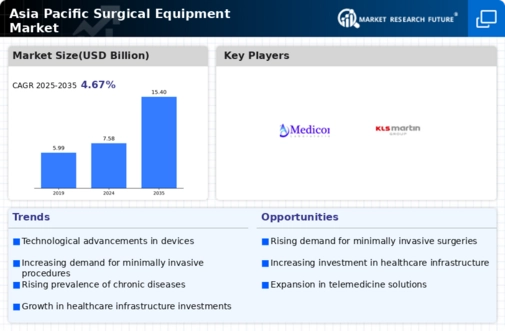Market Trends
Key Emerging Trends in the Asia Pacific Surgical Equipment Market
The Asia-Pacific surgical equipment market is undergoing significant trends shaped by technological advancements, the increasing demand for surgical procedures, and evolving healthcare infrastructures across the region. These trends reflect a dynamic landscape in surgical practices, with a focus on improving patient outcomes, enhancing procedural efficiency, and adapting to changing healthcare needs in Asia Pacific. In technological advancements of surgical equipment is one of the forces that drive the market trends. emergent technologies have changed the practices of the surgeon to be autonomous providing the crucial labors of the government are of the grade and the budget. The Asia Pacific region reflects a significantly intensifying desire for minimal invasive surgeries. The less invasive professional procedures have been accepted not only by the patients but also by their professionals resulting in greater adoption of laparoscopic, endoscopic, and robotic-processed based techniques in various surgical specialties. The field of robotics in surgical practices is growing popular. Harnessing the power of robotic-assisted surgical systems, surgeons gain improved precision, dexterity, and three dimensional visualization thereby enhancing effective outcomes as observed in complicated surgical procedures. Mining machine engages this trend specifically in urology, gynecology, and general surgery. In the market for Asia Pacific, surgical navigation systems play a more and more substantial role. Intraoperative imaging and patient tracking integrated with navigation systems are used by these systems to help surgeons navigate accurately in operations particularly in neurosurgery, orthopedics, and complex cancer surgeries. Radiofrequency: You can expect to see further improvement in electrosurgical instruments and as such they will drive market trends. Electronic instrumentation by starting advanced transmitter devices provide the defined clearance along with controlled coagulation that minimizes blood loss and the damages of the tissue during surgery. But such devices are on the verge of steep growth throughout many surgical specialties. During the last decade Asia Pacific has witnessed a steady growth towards using ambulatory surgical centers. Ambulatory Surgery Centers offer cost saving and better outcomes in comparison to traditional in-hospital surgery settings that attract the medical professionals working for such centers to seek surgical devices which are mobile, portable and small to take up less space for ease of movements. Human health and safety takes central focus in surgical setting in efforts to curtail infections. The market is also seeing a trend in vain on evolving surgical equipmentthat provides high safety features and materials with less amatagents or infections which goes along wtith the efforts to improve AHAIs internationally Surgical equipment trends of the future include customizability and made to order designs. As a result of the Novel COVID-19 pandemic, the reach of remote surgical support, as well as adoption of the telehealth practice has become highly pronounced. Surgical devices that are equipped with remote monitoring and connectivity allow surgeons to render consultations, advice or other forms of support even remotely, allowing continuity of care with minimal physical interventions. There has been a steady increase in the sort venture and collaborations between medical institutions and medical technology companies. These partnerships intend at unifying surgical devices with digital technologies, data analysis, and artificial intelligence to make a single package which incorporates comprehensive and systematized approaches to surgical treatment. Government initiatives and healthcare policies play a pivotal role in shaping market trends. Changes in healthcare policies and reimbursement systems influence the adoption of advanced surgical equipment, impacting both healthcare providers and patients in the Asia Pacific region.





Leave a Comment